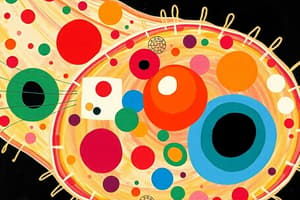Podcast
Questions and Answers
What is the primary function of the mitochondria in a cell?
What is the primary function of the mitochondria in a cell?
- Lipid synthesis and detoxification
- Modification and packaging of proteins
- Energy production (correct)
- Protein synthesis
Which organelle is responsible for the synthesis of proteins within the cell?
Which organelle is responsible for the synthesis of proteins within the cell?
- Golgi Apparatus
- Lysosome
- Ribosome (correct)
- Endoplasmic Reticulum
What role does the cell membrane play in maintaining homeostasis?
What role does the cell membrane play in maintaining homeostasis?
- Synthesize lipids
- Regulates energy production
- Controls the entry and exit of substances (correct)
- Communicates with other cells
During which stage of mitosis do the chromosomes align at the cell's equator?
During which stage of mitosis do the chromosomes align at the cell's equator?
What distinguishes meiosis from mitosis?
What distinguishes meiosis from mitosis?
Which component of the cell is primarily responsible for structural support and movement?
Which component of the cell is primarily responsible for structural support and movement?
What process is primarily involved in maintaining a stable internal environment within the cell?
What process is primarily involved in maintaining a stable internal environment within the cell?
Which organelle modifies, sorts, and packages proteins and lipids for secretion?
Which organelle modifies, sorts, and packages proteins and lipids for secretion?
Flashcards are hidden until you start studying
Study Notes
The Fundamental Unit of Life
Cell Structure
- Basic Unit: Cells are the smallest units of life, encapsulating all biological processes.
- Components:
- Cell Membrane: Semi-permeable barrier that controls entry and exit of substances.
- Cytoplasm: Gel-like fluid within the cell, containing organelles and cytosol.
- Nucleus: Contains genetic material (DNA); regulates cell activities.
- Organelles:
- Mitochondria: Powerhouse of the cell; energy production through respiration.
- Ribosomes: Protein synthesis; may be free in cytoplasm or attached to the endoplasmic reticulum.
- Endoplasmic Reticulum (ER):
- Rough ER: Studded with ribosomes; synthesizes proteins.
- Smooth ER: No ribosomes; involved in lipid synthesis and detoxification.
- Golgi Apparatus: Modifies, sorts, and packages proteins and lipids for secretion or use.
- Lysosomes: Digests worn-out cellular components and foreign materials.
- Cytoskeleton: Network of fibers for structural support, transport, and movement.
Cell Function
- Metabolism: Chemical reactions that occur in the cell to maintain life, including energy production (ATP).
- Homeostasis: Maintaining a stable internal environment despite external changes.
- Communication: Cells communicate through signals (chemical or electrical) to coordinate functions.
- Reproduction: Cells can reproduce via processes like mitosis (for growth and repair) or meiosis (for gamete formation).
Cell Division
-
Mitosis:
- Process of cell division resulting in two genetically identical daughter cells.
- Stages:
- Prophase: Chromatin condenses into chromosomes; nuclear envelope breaks down.
- Metaphase: Chromosomes align at the cell's equator.
- Anaphase: Sister chromatids are pulled apart to opposite poles.
- Telophase: Nuclear membranes reform; chromosomes decondense.
- Cytokinesis: Division of the cytoplasm, resulting in two separate cells.
-
Meiosis:
- Specialized form of cell division resulting in four genetically varied daughter cells (gametes).
- Stages include two rounds of division (meiosis I and II) with processes such as crossing over that increase genetic variability.
- Essential for sexual reproduction in eukaryotes.
These fundamental concepts establish the basis of understanding cells as the primary units of life in all living organisms.
Cell Structure
- Basic Unit: The cell is the fundamental unit of life.
- Cell Membrane: Controls what enters and exits the cell.
- Cytoplasm: Gel-like substance that holds organelles and cytosol.
- Nucleus: Contains DNA, the cell's genetic blueprint, and directs cell activity.
- Mitochondria: Powerhouse of the cell, produces energy (ATP) through cellular respiration.
- Ribosomes: Assemble proteins, and are found free in the cytoplasm or attached to the endoplasmic reticulum.
- Endoplasmic Reticulum (ER)
- Rough ER: Studded with ribosomes, synthesizes proteins
- Smooth ER: No ribosomes, produces lipids and detoxifies substances.
- Golgi Apparatus: Processes, packages, and delivers proteins and lipids for secretion or use within the cell.
- Lysosomes: Responsible for breaking down and digesting worn-out cell parts and foreign materials.
- Cytoskeleton: Provides structural support, allows for movement, and assists with transportation within the cell.
Cell Function
- Metabolism: Chemical reactions occur within the cell to sustain life, including energy production.
- Homeostasis: Cells maintain a stable internal environment despite external fluctuations.
- Communication: Cells interact by sending and receiving signals to coordinate functions.
- Reproduction: Cells reproduce through mitosis (for growth and repair) or meiosis (for gamete formation).
Cell Division
- Mitosis: Division of a parent cell into two genetically identical daughter cells.
- Prophase: Chromatin condenses into chromosomes and the nuclear envelope breaks down.
- Metaphase: Chromosomes line up at the center of the cell.
- Anaphase: Sister chromatids (replicas of a chromosome) are pulled apart and move to opposite poles of the cell.
- Telophase: Nuclear membranes reform around each set of chromosomes, chromosomes uncoil, and the cell begins to divide.
- Cytokinesis: The cytoplasm divides, resulting in two independent daughter cells.
- Meiosis: Special type of cell division resulting in four genetically unique gametes (sex cells).
- Involves two rounds of division (meiosis I and II) with key events like crossing over (exchange of genetic material) that increase genetic diversity.
- Essential for sexual reproduction in eukaryotes.
Studying That Suits You
Use AI to generate personalized quizzes and flashcards to suit your learning preferences.




